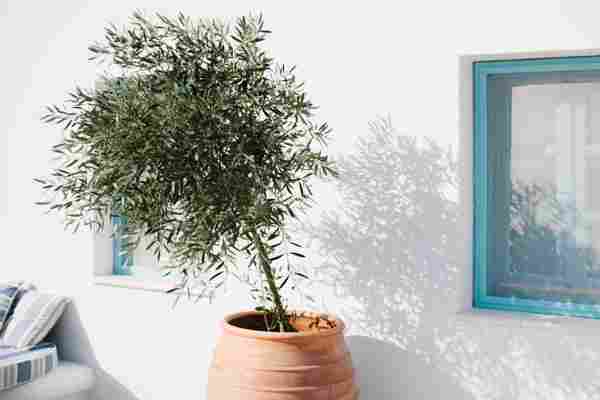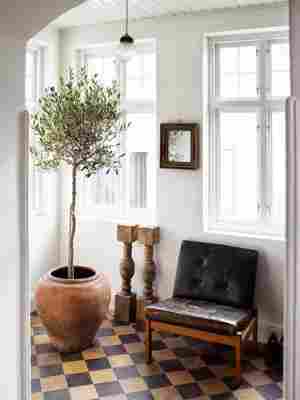Olive Trees Are “Next Big Thing” Tree Taking Over the Design World (& How To Take Care of It)

Given the current craze for houseplants, it’s hard to imagine there’s any un-trod territory there, and yet — I was totally surprised to realize that you can grow an olive tree inside. Of course, once I started looking for them I began to see olive trees everywhere, and wondered why I didn’t notice them before. This is a trend I could see really taking off: olive trees, with their light, sage-colored foliage, work beautifully in modern interiors. They have a certain sophistication, as if you have just brought a tiny bit of Tuscany into your living room. If you’re considering growing one of these beauties, here’s everything you need to know.

Sun
Unfortunately for those of us living in cavelike spaces, the olive tree, like most fruit trees, prefers full sun (at least six hours a day). A sunny, south-facing window is ideal.
Size
Although olive trees can reach up to ten feet in containers, unless your ceilings are particularly high you’ll probably want to opt for a dwarf variety. Dwarf olive trees will grow as tall as six feet, although you can keep them shorter by pruning them.
Planting
Olive trees like soil that drains easily, like a cactus mix. Placing a inch or two of styrofoam, gravel, or any other kind of filler on the bottom of the pot will keep the soil well drained. (And of course, make sure your container has plenty of drainage holes.) Although olive trees grow quite slowly, you want to make sure that the container is at least several inches larger than the root ball on each side to allow the roots room to expand. Planting in a larger container will mean you’ll have to re-pot your tree less often.
Care
Allow the top inch of soil in the pot to try out in between waterings. Olive trees, since they are native to the Mediterranean, are particularly suited to drier air (like the kind found in most homes), so they don’t need to be misted.
Growing Fruit
If you want your olive tree to provide you with actual olives, as well as looking pretty, make sure the variety you buy is fruit-bearing and not purely ornamental. The folks at Food52 recommend the Arbequina or Picholine varieties. According to HGTV , olive trees need to be placed outside for a few months in order to set fruit (it has to do with the change in temperatures), so your mileage may vary.
The Bad News
Although olive trees can be grown indoors, they can’t be grown indoors forever . Multiple sources I found stated that olive trees can only live indoors for eight to nine years . (What happens after the eight to nine years is not specified — perhaps they wilt away from longing?) Still, eight to nine years is a pretty good run — and you might even get some fruit from it in the meantime.
For Further Reading:
• How To Grow an Olive Tree from HGTV
• Planting Olive Trees in a Pot from McEvoy Ranch
Re-edited from a post originally published 2.1.17
Your comment